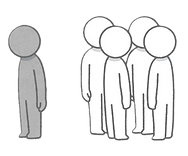Neurodiversity 101

What is neurodiversity?
The differences in our brain functions and behavior traits are part of normal variation in human population. Neurodiversity includes everyone!
What is strengths-based model?
This model assumes competence and empowers us by recognizing our strengths!
How is the strengths-based model different from the traditional medical model?
The medical model looks at "what is wrong" that "needs to be fixed." Unfortunately, it reinforces societal beliefs that differences are deficits, abnormalities, or disabilities. The strengths-based model, on the other hand, looks at what people are good at or can be great at while scaffolding where they need support. Rooted in social model, strengths-based model also helps to overcome cultural stigma associated with differences and promotes a neuroinclusive society! Check out an example here.
Another important difference is that the medical model leans on caregivers to make decisions for those differently abled, while the strengths-based model promotes autonomy and decision-making by the individual. Learn more here.
Why is the strengths-based model so important for us, the youth?
The traditional model assumes that there is a "normal" way of learning, behaving, communicating, etc. So, anyone who has a difference is assumed to have "deficits." Countless examples come to mind - "Oh, you are not taking notes neatly; you are fidgeting too much; why are you looking away when I'm talking to you; did I not tell you that negative of negative is a positive, how many times will you get it wrong; stay on topic or don't go so deep, we have lot to cover, and so on."
The concept that there is a "normal" and those who are different are not normal has isolated many youth, forcing many to "mask," and labeled others in categories separate from the rest. We all know how we feel when we are excluded.


And that is why the strengths-based model is not only important, but essential. It presumes that each of us is competent with unique strengths and much to add! Strengths-based model promotes a positive, inclusive, and uplifting society in which all are celebrated for who they are, scaffolding is not seen as burdensome, & everyone is empowered to reach their unique potential!
Common definitions (Source: SNP)
Neurotypical: those whose brain function and/or behavior traits are more common (68% of the human population)
Neurodiverse/Neurodivergent: those who are not neurotypical. Differences could be in one or more areas.

Spectrum wheel by the Vanderbilt University's Frist Center of Autism & Innovation
What are some examples of neurodivergence?
Autism - Spectrum of traits. Brain wired for deep focus, patterns, and literal thinking. Social cues can be hard, senses may overwhelm, routines feel safe, and special interests bring joy. ADHD: Brain runs low on “focus fuel” (dopamine). Hard to sit still, or wait, hard to start or finish tasks, — but can hyperfocus on things that spark joy. Dyslexia: Brain reads and spells differently (not an eye problem). Letters flip, words feel slow, but storytelling, art, and big ideas come easily. Dyscalculia: Brain struggles with numbers and math logic. Counting, time, or money feels confusing — but words, music, or creativity flow freely. Dyspraxia: Brain and body don’t sync smoothly. Handwriting hurts, balance wobbles, planning steps is tough — but imagination and creativity flow freely. Dysgraphia: Writing by hand is physically painful or slow. Ideas race ahead of the pen — typing or talking works much better. Tourette Syndrome: Brain sends random “blips” → tics like blinking, sniffing, or sudden words. Tics come and go, often worse when stressed. OCD: Brain gets stuck in worry loops. Rituals and thoughts repeat. Sensory Processing Disorder: Brain over- or under-reacts to sound, touch, smell. Tags itch like fire, crowds feel like storms — or craves hugs, motion, pressure. Twice-Exceptional (2e): Brain thinks fast and deep (gifted, high IQ), but may hide other differences like ADHD, autism, dyslexia, or more. Bipolar Disorder: Brain mood swings between super high energy (mania) and deep lows (depression). Creative bursts in ups, rest needed in downs.
Learn more:
Note from us: We do not like the traditional suffix of "Disorder" in many of the terms above.
What is sensory sensitivity? Why is it important for all youth to know about it?
Neurodivergent youth can have very heightened or very muted sensations to sound, light, smell, touch, taste, balance, etc. Feeling overwhelmed, scared, on fire, or turning non-verbal, are some of many debilitating symptoms. We must all learn about this topic since we share so many common spaces. We encourage neurotypical youth to watch this video to experience what sensory overload can feel like for our neurodivergent peers.
What is Double Empathy Opportunity?
Due to differences in neurotypes, it is but natural that neurotypical and neurodivergent people can have trouble perceiving and understanding each other. The Frist Center of Autism & Innovation reframed the double empathy problem into an opportunity to "learn from one another, be innovative and creative, as we build a neuroinclusive society together."
Watch the video below to learn more social misunderstandings.
Written by Aashna Parsa, 10/20/2025







